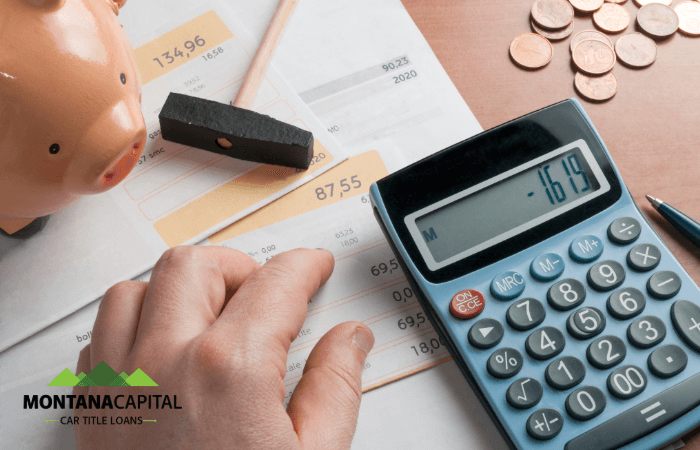Finding yourself with an overdrawn bank account can be stressful, especially when you don’t have the funds to cover the deficit. While it’s an overwhelming situation, there are steps you can take to fix your balance and prevent future issues. The key is to act quickly to avoid further fees and penalties.
In this article, we’ll outline practical strategies to help you address a negative bank account, manage the situation, and explore options even when you don’t have money on hand.
Key Takeaways
- Immediate Action is Crucial: Stop all transactions when you notice your account is overdrawn to avoid additional fees. Quickly determine the amount needed to restore your account to a positive balance.
- Understand the Fees: Overdraft fees can quickly accumulate, including extended fees if your account remains negative for multiple days. Be aware of the different fees that may apply to your account.
- Explore Financial Assistance Options: If you can’t cover the negative balance immediately, consider borrowing from family or friends, finding quick income sources, or exploring personal loan options.
- Communicate with Your Bank: Contact your bank to discuss potential fee waivers, repayment plans, or solutions to address your negative balance and avoid further complications.
- Take Preventive Measures: Set up low balance alerts and track your spending to avoid future overdrafts. Linking accounts for overdraft protection can also help prevent negative balances in the future.
What is an Overdraft?
An overdraft occurs when your bank allows a transaction to go through despite insufficient funds in your account, effectively granting you a short-term loan. This can be a lifeline in moments of financial tightness, enabling you to continue making necessary payments even when your account balance hits zero or goes negative. However, this convenience comes at a cost. Banks typically charge fees for overdrafts, which might include one-time insufficient funds fees and interest on the borrowed amount.
Some banks offer overdraft protection to mitigate these charges, linking your checking account to a savings account or a credit line to cover overdrafts without extra fees. Nevertheless, using overdrafts can lead to extra expenses if not managed properly, resulting in accumulating interest and fees over time.
Understanding how overdrafts work helps you to avoid overdrafts and unnecessary financial strain.
Immediate Steps to Take When Your Bank Account is Negative
When you discover your bank account is negative, act quickly. Stop using the account to prevent more overdraft fees. Determine how much money you need to restore a positive balance, considering pending transactions and fees. Deposit money into your account immediately to cover the negative balance and avoid further charges.
These steps help you manage the situation effectively and prevent additional complications moving forward.
Stop Using Your Overdrawn Account
Once you realize your overdrawn bank account is overdrawn, halt all transactions immediately, including debit card purchases and automatic payments, to avoid further fees. Each additional transaction can incur more charges, compounding your financial burden.
Halting all account activity prevents further fees, giving you a chance to rectify the negative balance efficiently.
Assess Exactly How Much Money You Need
Accurately determining the amount needed for balancing the return to a positive balance involves considering all pending transactions and associated fees. Overlooking pending transactions can lead to an inaccurate assessment and additional transactions that result in overdrafts.
Knowing exactly how much money you need helps you plan effectively to cover the shortfall and prevent future overdrafts, ensuring you have enough money for your expenses.
Deposit Money into Your Account ASAP
Deposit money into your account quickly. Use an ATM, visit your local bank branch, or transfer money online. This helps cover the negative balance and stops further overdraft fees. Direct deposits also help in restoring a positive balance.
To effectively restore a positive bank account balance, deposit enough to cover the overdraft and any additional charges. Acting swiftly can also leverage any grace periods offered by banks to avoid extra fees.
Communicating with Your Bank
When your bank account is negative, clear communication with your bank is crucial. If you’re unsure why your account is overdrawn, contacting your bank can provide clarity and help address the situation promptly. Discussing your negative balance with a bank representative can also lead to fee waivers or a repayment plan. Regular communication ensures you stay informed about your account status and bank policies, helping you manage your finances better.
These subsections highlight the importance of reaching out to customer service and understanding your bank’s specific policies on overdrafts and fees. This knowledge empowers you to navigate your financial situation more effectively.
Contact Customer Service
Reaching out to customer service is pivotal when dealing with a negative bank account. Highlight any previous positive banking history to strengthen your case for waived fees. A bank representative can provide insights into managing the negative balance and may offer fee waivers or flexible repayment plans.
Understand Your Bank’s Policies
Understanding your bank’s policies on fees and overdrafts prevents unexpected charges and helps you manage your finances more effectively. Familiarize yourself with the fee structure and terms related to overdrafts to avoid unnecessary charges and prepare for potential financial challenges.
This knowledge will empower you to make informed decisions and navigate your financial situation with confidence.
Exploring Financial Assistance Options
When facing a negative bank account balance, exploring financial assistance options can be a lifesaver. Options include borrowing from friends or family, seeking quick income solutions, or applying for personal loans and credit options. Each option has its advantages and potential risks, so it’s important to choose the best one for your situation.
Borrowing from Friends or Family
Borrowing from friends or family can provide immediate financial relief. However, communicate clearly about the terms and expectations to avoid straining relationships. This option offers flexibility in repayment terms that traditional lenders may not provide, but clear communication is essential to prevent misunderstandings.
Quick Income Solutions
Engaging in quick income-generating activities can swiftly cover a negative bank balance. Freelance work, gig economy jobs, and selling items online are effective methods to raise funds quickly.
These opportunities offer immediate cash flow, addressing urgent financial needs and restoring your account balance.
Personal Loans and Credit Options
Personal loans and credit options can temporarily cover a negative bank balance. For individuals with poor credit history, online platforms offering small loans without credit checks can be particularly beneficial.
Car title loans are another option for those in need of quick cash. By using your car title as collateral, you can secure a loan even with a negative bank account balance. However, it’s important to be cautious, as these loans often come with the risk of losing your vehicle if you fail to repay the loan.
These loans provide immediate funds and help manage financial emergencies, though it’s important to consider the terms and potential interest rates.
Important Lender Tip:
While title loans can offer quick access to cash, we recommend using them strictly for emergencies due to their high-interest rates and potential risks. It’s crucial to carefully consider the terms and ensure you can repay the loan promptly to avoid losing your vehicle or incurring additional financial burdens. Always explore several options to find what works best for you before deciding on a title loan.
Take Action to Prevent Future Overdrafts
Preventive measures are key to avoiding future overdrafts. Utilizing online banking tools, setting up low balance alerts, and regularly tracking spending can significantly reduce the risk of negative balances. Additionally, linking accounts for overdraft protection ensures transactions are covered even if your checking account balance is low.
The following subsections explore these preventive measures in detail, helping you establish habits and systems to prevent future overdrafts.
Sign Up for Low Balance Alerts
Setting up low balance alerts through online banking keeps you informed about your account balance, allowing you to take timely action to prevent overdrafts. These alerts notify you when your balance drops below a specified amount, enabling you to transfer money or reduce spending to avoid overdraft fees.
Track Spending and Maintain a Budget
Maintaining a budget and regularly tracking your spending are essential habits to avoid future overdrafts. Recording every deposit and withdrawal keeps you organized with your finances and ensures you have enough funds to cover your expenses.
Link Accounts for Overdraft Protection
Linking your accounts for overdraft protection allows for quick transfers from savings accounts or credit accounts to your checking account, covering transactions and avoiding fees.
Using funds from a linked account provides a safety net, ensuring your transactions are always covered.
Understanding the Consequences of an Overdrawn Account
Maintaining a negative bank account balance can have serious consequences. Accumulating fees and potential account closure are significant risks if the negative balance is not addressed promptly. Extended periods of a negative amount can lead to additional fees and impact future banking opportunities.
Overdraft Fees and Charges
Overdraft fees typically range from $30 to $40 per transaction, depending on the bank. Paying overdraft fees and other fees can accumulate quickly if transactions continue while the account is negative, leading to a typical overdraft fee. Banks may charge overdraft fees if the account is negative.
Extended overdraft fees may also be charged if the account remains negative for several days, starting after the first five days.
Understanding Bank Overdraft Fees:
- Standard Overdraft Fee: This is the fee charged when you spend more than the money in your account, usually between $30 and $40.
- Overdraft Transfer Fee: If the bank transfers money from another account to cover your overdraft, they may charge a fee.
- Extended Overdraft Fee: If your account stays negative for several days, you may be charged extra fees.
- Non-Sufficient Funds (NSF) Fee: This fee is charged if a payment is attempted but there aren’t enough funds in your account to cover it.
Potential Account Closure
Long-term negative balances can result in your bank closing your account and attempting to collect the outstanding balance. If unresolved, this can lead to significant financial complications and impact your ability to open new accounts in the future, including a negative account.
Reviewing your account’s terms and conditions helps you understand these consequences and take preventive measures.
Managing Automatic Payments and Recurring Transactions
Managing automatic payments and recurring transactions helps prevent overdrafts. Consistently monitoring your account balance and ensuring payments coincide with available funds avoids financial pitfalls. Aligning payment schedules with your paydays ensures funds are available when payments are due.
The following subsections discuss strategies for scheduling payments, reviewing recurring transactions, and understanding the impact on your credit history.
Schedule Payments Strategically
Scheduling automatic payments for the business day after receiving your paycheck ensures funds are available when payments are due, reducing the risk of overdrafts and associated fees. You can also pay your bills on time this way.
Review and Adjust Recurring Transactions
Regularly reviewing and adjusting your recurring transactions helps manage your account balance more effectively. Scheduling automatic payments for dates after your payday ensures sufficient funds are always available while paying attention to your budget and ensuring that all bills are paid.
Maintaining a budget and tracking your spending keeps you informed about your finances and ensures you have enough for recurring charges.
Impact on Credit History
A bank may report an unresolved negative balance to a collection agency, significantly impacting your credit history. Repeated overdrafts can signal financial instability, negatively influencing your credit history. Engaging in debt collection efforts due to unresolved overdrafts can damage your credit score, making it crucial to manage your account properly to avoid negative credit reporting. Debt collectors can also play a role in this process.
Utilizing Online Banking Tools
Online banking tools streamline managing your bank account and help avoid negative balances. By setting up low balance alerts, you receive notifications before overdrawing. These platforms offer budgeting features that track spending, ensuring you maintain a positive balance.
The subsections below highlight the advantages of mobile banking apps and budgeting tools in preventing overdrafts and effectively managing your finances.
Mobile Banking Apps
Mobile banking apps allow you to monitor your balances in real-time and often provide notifications for low balances. These apps support accurate record-keeping and help you keep track of your bank account balance.
Manually tracking transactions and using mobile banking features helps you manage your finances more effectively and prevent overdrafts.
Budgeting Tools and Features
Online banking tools with budgeting features enable you to track your spending and maintain a positive account balance. Keeping an accurate account balance and accessing your bank accounts information anytime can prevent overdrafts and financial stress.
Using these tools helps you stay organized and informed about your financial status.
Summary
Managing a negative bank account balance requires swift action, clear communication with your bank, and exploring financial assistance options. Prevent future overdrafts by setting up low balance alerts, maintaining a budget, and linking accounts for overdraft protection. Utilize online banking tools to manage finances effectively. Proactive management and informed decision-making are essential to maintaining financial health and avoiding the stress of negative balances.
For personalized assistance and to explore personal loan options, contact us or fill out a request form to see how much you can get with no obligation.
Frequently Asked Questions
How Do I Fix a Negative Bank Account with No Money?
To fix a negative bank account with no money, stop all transactions to avoid more fees. Contact your bank to discuss possible fee waivers or repayment plans. Consider borrowing from friends or family, finding quick income solutions, or exploring personal loan options. Use online banking tools and set up low balance alerts to prevent future overdrafts.
Can I Go to Jail for an Overdrawn Bank Account?
No, you cannot go to jail simply for having an overdrawn bank account. Overdrafts are a financial issue, not a criminal one. However, if you knowingly write checks or make transactions without sufficient funds with the intent to defraud, this could lead to legal consequences.
What Happens If Your Bank Account Goes Negative and You Can’t Pay It?
If your bank account goes negative and you can’t pay it, your bank will likely charge overdraft fees. Persistent negative balances can lead to extended overdraft fees and even account closure. If unresolved, the bank may involve debt collectors, impacting your credit history and future banking opportunities.
Can I Borrow Money if My Account is Negative?
Yes, you can borrow money even if your account is negative, but it may come with certain challenges. Banks and traditional lenders may be hesitant to offer loans if your account is overdrawn. However, you have alternative options like borrowing from friends or family, applying for a personal loan from online lenders, or using credit options such as payday loans or title loans.
It’s crucial to understand the terms and potential high-interest rates associated with these options to avoid further financial strain. Always explore multiple avenues and choose the one that best suits your situation.



